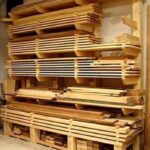A mallet is a versatile tool in woodworking that serves as a crucial instrument for various tasks. Whether it’s chiseling, carving, or assembling pieces of wood, a mallet plays a significant role in the woodworking process. But what is a mallet used for in woodwork? This article aims to explore the purpose and significance of the mallet in woodworking, from its history and types to techniques for using it effectively.
The history of the mallet dates back centuries, with its origins deeply rooted in the craftsmanship of woodworking. As one of the earliest hand tools used by humans, the mallet has evolved over time to meet the diverse needs of woodworkers. Today, there are various types of mallets designed for specific woodworking tasks, each with its unique features and benefits.
When it comes to woodworking, having the right tools can make all the difference in achieving precision and quality. Understanding the different types and materials used to make mallets is essential for selecting the best tool for specific woodworking projects.
Additionally, mastering techniques for using a mallet effectively can significantly improve woodworking outcomes while minimizing potential errors. Throughout this article, we will delve into these aspects and more to provide valuable insights into what makes a mallet an indispensable tool in woodworking.
History of the Mallet
The history of the mallet dates back to ancient times and has been an essential tool in woodworking for centuries. The mallet is a versatile tool used by woodworkers across different cultures and time periods, showing its significance in various woodworking tasks.
Tracing back the origins of the mallet, it can be found in early civilizations such as Ancient Egypt, where wooden mallets were used in shaping and carving wood for construction and artistic purposes. In many cultures, the use of the mallet evolved over time, reflecting changes in woodworking techniques and designs.
Different types of mallets have been used throughout history, each serving specific purposes in woodworking. The common mallet types include wooden mallets, rubber or plastic mallets, and metal or brass head mallets. Each type of mallet has unique properties that make them suitable for specific woodworking tasks. For example, wooden mallets are often used for delicate chiseling work, while rubber or plastic mallets are ideal for assembling joints without damaging the wood.
The materials used to make mallet heads have also evolved over time, with traditional materials such as wood and stone being replaced by modern alternatives like rubber and synthetic compounds. These advancements in material technology have allowed for more versatility in using a mallet for different woodworking applications. Understanding the historical development of different types of mallets and their materials provides valuable insights into the evolution of woodworking techniques and tools.
| History of Mallet | Tracing Back Origins |
|---|---|
| Ancient Egypt | Use in shaping and carving wood |
| Evolution | Changes in woodworking techniques |
Types of Mallets
When it comes to woodworking, having the right tools is essential for achieving precision and quality in your projects. One such tool that is commonly used in woodworking is the mallet. A mallet is a type of hammer with a large, often wooden head, used especially for hitting a chisel or wedge. The mallet is an important tool in woodworking as it provides woodworkers with a way to apply force without damaging delicate surfaces or leaving behind marks.
Traditional Wooden Mallets
Traditional wooden mallets are one of the most common types of mallets used in woodworking. These mallets typically have a cylindrical, turned wooden head and a handle that is also made from wood. They are preferred for their lightweight design and softer striking surface. This makes them ideal for tasks that require more finesse and precision, such as driving chisels or carving tools.
Carpenters’ Mallets
Carpenters’ mallets are another popular type commonly used in woodworking tasks. These mallets feature a larger head made of hardwood and can have either a wooden or metal handle. Carpenters’ mallets are often heavier than traditional wooden mallets, making them suitable for heavier-duty tasks like assembly work or driving dowels into place.
Rubber Mallets
Rubber mallets are slightly different from traditional wooden and carpenters’ mallets in that they have a rubberized head instead of wood. This makes them ideal for tasks where you need to exert force but don’t want to leave any marks on the workpiece. Rubber mallets are commonly used when assembling furniture or other woodworking projects where surfaces need protection from direct impact.
Understanding the different types of mallets available to woodworkers allows them to choose the right tool for each specific task based on their needs and desired outcome. Each type of mallet has its own advantages and considerations, making it important for woodworkers to have a variety at their disposal.
Materials Used
Mallets used in woodworking are made from a variety of materials, each with its own unique impact on the woodwork. The material used for making a mallet can significantly affect the durability, functionality, and overall performance of the tool. Here are some of the most commonly used materials for making mallets and their impact on woodwork:
- Wood: Traditional wooden mallets are popular among woodworkers due to their natural feel and soft impact on delicate wood surfaces. They are lightweight and provide a good balance between force and precision when striking chisels or carving tools.
- Rubber: Mallets with rubber heads are excellent for tasks that require a softer touch, such as assembling or disassembling joinery without damaging the wood surface. The rubber material absorbs shock and minimizes the risk of leaving marks on the workpiece.
- Plastic: Mallets made from plastic are ideal for heavy-duty tasks where high impact is required. They are durable, resistant to wear and tear, and suitable for tasks like driving chisels or adjusting wooden components.
- Rawhide: Mallets with rawhide heads provide a softer impact than metal hammers while still delivering enough force for shaping or forming wooden pieces. Rawhide mallets are often used in leatherworking as well.
The choice of material for a mallet depends on the specific woodworking task at hand, as well as personal preference and comfort in handling the tool. Some woodworkers may opt to have multiple mallets made from different materials to cater to various needs.
Ultimately, regardless of the material used, a well-crafted mallet should be balanced, comfortable to hold, and able to deliver controlled force without causing damage to delicate woodworking projects.
By understanding the different materials used in making mallets and their varying impacts on woodwork, woodworkers can make informed decisions when choosing the right tool for their specific woodworking tasks. Each material has its own advantages and limitations, so it’s essential to consider these factors when selecting a mallet that best suits individual preferences and project requirements.
Techniques for Using a Mallet
Proper Grip and Stance
When using a mallet in woodworking, it is important to ensure that you have the proper grip and stance to effectively and safely use the tool. Hold the mallet with one hand at the end of the handle, while using your other hand on top of the mallet head for better control. Stand with your feet shoulder-width apart and position yourself in front of the workpiece, maintaining a balanced and stable stance.
Striking Techniques
The key to using a mallet effectively lies in mastering the striking techniques. Whether you are using a wooden mallet, rubber mallet, or rawhide mallet, the way you strike the chisel or workpiece can make all the difference. Aim for controlled and consistent strikes, using your arm rather than just your wrist to generate force. It’s important to strike straight down onto the surface without angling the mallet to prevent any unwanted deflection of force.
Targeted Application
Understanding where and how to apply the force when using a mallet is essential in achieving desired results in woodworking tasks. For chiseling tasks, focus on striking directly at the end of the chisel handle to drive it into wood with precision.
When assembling wood pieces together, use gentle taps with a soft-faced mallet to avoid causing damage while ensuring a secure fit. Knowing when to use different types of mallets based on the task at hand is also crucial for successful woodworking projects.
By perfecting these techniques and understanding how different types of mallets may be utilized, woodworkers can achieve efficient results in their woodworking projects while minimizing errors and damage caused by improper use.
Benefits of Using a Mallet
A mallet is a versatile tool that serves as a crucial instrument in woodworking. It is used to strike chisels, carving tools, and other wooden-handled tools without damaging them. Below are some of the key benefits of using a mallet compared to other tools in woodworking:
- Controlled Striking: Unlike hammers, which are generally heavier and have metal heads, mallets are designed to deliver controlled striking force. The softer material of the mallet head prevents damaging delicate wood surfaces or the cutting edge of tools.
- Reduced Vibrations: When using a hammer to strike wood or tools, the impact can create strong vibrations in the hand and arm, leading to fatigue and discomfort. Mallets minimize these vibrations due to their softer material, providing more comfort during prolonged use.
- Versatility: Mallets come in various sizes and shapes, making them suitable for different woodworking tasks. From carving and shaping wood to assembling joinery with dovetails and mortise-and-tenon joints, a mallet can be adapted for numerous applications.
Common Mistakes When Using a Mallet
When working with a mallet in woodwork, there are several common mistakes that individuals should be aware of to ensure both their safety and the quality of their work. One common mistake is using excessive force when striking the chisel with a mallet.
While it may seem like applying more force will speed up the process, it can actually result in damage to the chisel or the wood being worked on. It’s important to use controlled and precise strikes with the mallet to avoid any mishaps.
Another mistake to avoid is using the wrong type of mallet for the task at hand. Different woodworking tasks require different types of mallets, and using the wrong one can lead to inefficiency and potential damage. For example, a carver’s mallet is designed for delicate and intricate work, while a joiner’s mallet is better suited for heavier tasks such as driving chisels.
Furthermore, not properly securing the piece of wood being worked on can also lead to mistakes when using a mallet in woodwork. Failing to secure the workpiece in place can result in it moving unexpectedly when struck by the mallet, leading to inaccurate cuts or potentially causing injury. It’s essential to use clamps or other securing methods to prevent this from happening.
Overall, understanding these common mistakes when using a mallet in woodwork is crucial for achieving successful and safe results. By avoiding these errors, individuals can work efficiently and effectively while minimizing the risk of accidents or damage to their woodworking projects.
| Common Mistakes When Using a Mallet | How to Avoid Them |
|---|---|
| Using excessive force | Use controlled and precise strikes with the mallet |
| Using the wrong type of mallet | Match the mallet type with the specific woodworking task |
| Failing to secure the workpiece | Use clamps or other securing methods |
Maintenance of Mallets
In conclusion, the mallet is an essential tool in woodworking, with a rich history that dates back centuries. From its origins to the various types and materials used to make mallets, it is clear that this tool plays a significant role in the craft of woodworking. Whether it’s for carving, chiseling, or assembling pieces of wood, the mallet provides a unique advantage over other tools due to its design and functionality.
The techniques for using a mallet are straightforward but require precision and skill to achieve desired results. It is important to understand the proper way to use a mallet in order to avoid common mistakes that could potentially damage the wood or compromise the integrity of the project. Additionally, knowing how to maintain and care for mallets is crucial for ensuring their longevity and effectiveness in woodworking tasks.
When it comes to maintenance, keeping the mallet clean and free from debris is important. Regularly inspecting the head and handle for any signs of wear or damage is also necessary. Proper storage in a dry environment will help prevent deterioration of the materials and ensure that the mallet remains in good working condition. Understanding these tips for maintaining mallets will not only prolong their lifespan but also contribute to quality woodworking for years to come.
Frequently Asked Questions
What Does Mallet Use For?
A mallet is a tool with a large, usually wooden or rubber head, used for striking or hitting objects. It can be used in various applications such as woodworking, metalworking, and construction.
What Is a Mallet Used for in Cooking?
In cooking, a mallet is typically used to tenderize meat by pounding it to break down the muscle fibers and connective tissue. This process helps to make the meat more tender and easier to chew when cooked.
Is a Mallet a Tool Used for Carving?
While a mallet is often associated with woodworking and meat tenderizing in cooking, it is not typically used for carving. Carving tools such as chisels, gouges, and knives are more commonly used for shaping and sculpting wood or other materials.

Hi everyone! I’m a woodworker and blogger, and this is my woodworking blog. In my blog, I share tips and tricks for woodworkers of all skill levels, as well as project ideas that you can try yourself.





